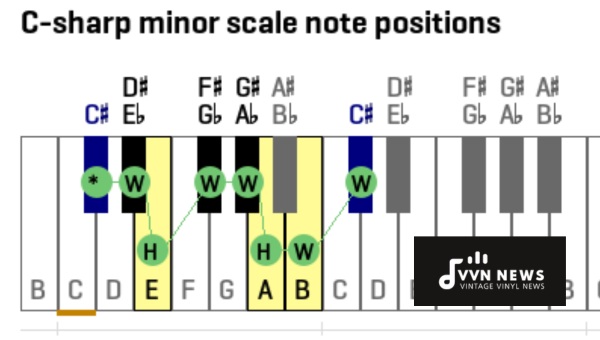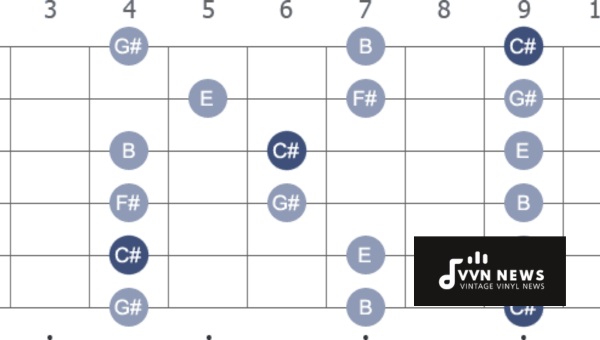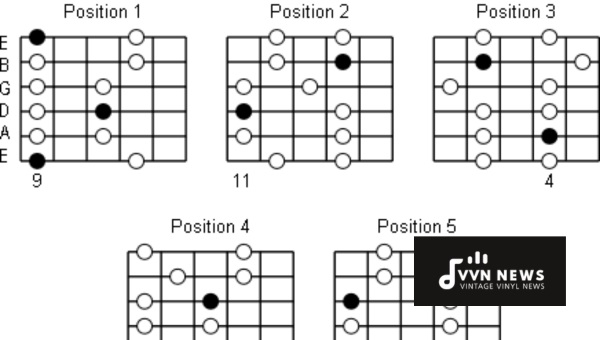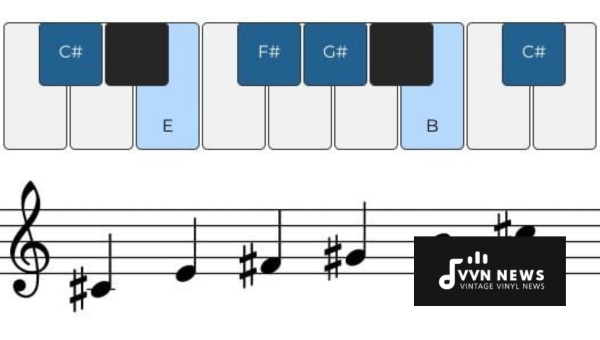Understanding the beauty of the C Sharp Minor Pentatonic Scale can be quite an enlightening musical journey.
This scale, popularly used in everything from classical to rock music, has a haunting yet enthralling melody that leaves an indelible impression on any listener.
It’s like a hidden gem with its unique intervals waiting to be delved into by any music aficionado.
The C Sharp Minor Pentatonic Scale might sound intricate, but it is quite simple once you understand its structure and see how it fits into the broader framework of music theory.
Its touch of melancholy flavor blended with sonic richness makes it a favorite among musicians, song composers, and learners alike.
Let me guide you through this journey, breaking down complexities and enlightening you with practical knowledge so you can master this scale and bring its mystique melody to life.
What is the C Sharp Minor Pentatonic Scale?
The C Sharp Minor Pentatonic Scale is at the heart of countless timeless pieces across a broad spectrum of genres.
This 5-note scale consists of five notes: C# (root), E (minor third), F# (perfect fourth), G# (perfect fifth) and B (minor seventh).
In essence, it omits the second and sixth of the full seven-note minor diatonic scale to create a distinctive sound that lends itself beautifully to improvised solos.
The compactness of this scale adds a layer of depth, providing a melodic canvas for musicians to express intensity without the constraint imposed by additional notes.
How to Construct the C Sharp Minor Pentatonic Scale

The foundation of the C Sharp Minor Pentatonic Scale lies in its formula.
A minor pentatonic scale consists of five notes or degrees, abbreviated as [1, b3, 4, 5, b7].
This construct implies the first note (root), minor third, fourth note, fifth note, and flat seventh.
To build a C Sharp Minor Pentatonic scale:
- The first note (root) would be
C#. - For the minor third (
b3), count three half-steps from C#, which provides you withE. - The fourth degree (
4) can be obtained by moving two whole steps from E leading you toF#. - The fifth degree (
5), requires moving one and a half-step from F#, landing onG#. - Finally, to obtain the flat seventh (
b7), shift up two whole steps from G#, which gives youB.
This sequence – C#, E, F#, G#, B – constitutes your desired C Sharp Minor Pentatonic Scale. Remember this pattern and apply it judiciously as you navigate your musical journey.
Also Read: C Sharp Minor Chords [Simple Guide For Aspiring Musicians]
The Five Shapes of the C Sharp Minor Pentatonic Scale
Any discussion about guitar scales runs into the concept of ‘shapes’. Just as there are unique shapes to every scale, the C Sharp Minor Pentatonic Scale has five distinct shapes that will take your playability to another level. So let’s delve into exploring these shapes.
The Standard Shape
The most commonly known variant is the Standard Shape. Imagine standing in front of a guitar’s fretboard.
For this shape, start with the 4th fret on the string with the help of your index finger.
e|———————————–4-7–|
B|—————————–4-7——–|
G|———————4-6—————-|
D|————–4-6———————–|
A|——-4-7——————————-|
E|–4-7———————————-|
The Extended Shape
Next up is the Extended shape. It starts from the 7th fret and extends up to the 11th fret on your guitar’s fretboard.
e|——————————–9-12—-|
B|—————————-9-12——–|
G|———————9–11—————|
D|————–9–11———————-|
A |——-10–12—————————-|
E |–9–12———————————|
The Higher Octave
Then we have the Higher Octave, kicking off at the 12th fret, essentially repeating the first shape but an octave higher.
e|——————————–16-19—- |
B |—————————-16–19——– |
G | ——————-16–18 —————- |
D |————-16–18 ———————- |
A|–16–19 ——————————– |
E |–16–19 ——————————– |
Sevenths Galore
Following that is a shape that is rich in sevenths, which we’ll call Sevenths Galore.
e|—————————-6–9 ——— |
B|————————7–9 ————- |
G|—————–6–8 ——————– |
D|—————6–8 ———————-|
A |— 7–9 ——————————–|
E |–7–9 ———————————-|
The Low Octave
Finally, we have the Low Octave, starting from the ninth fret and spanning to the twelfth fret.
e|——————————-14-16———–|
B|————————–14-17—————-|
G |——————14-16———————–|
D |————–14-16—————————-|
A|——–14-17———————————-|
E|–14-17—————————————|
To become proficient with the C Sharp Minor Pentatonic Scale, it’s pivotal that you familiarize yourself with these distinctive shapes.
The key is to not rush through these but diligently practice one shape at a time.
Comparable Scales to the C Sharp Minor Pentatonic Scale

The C Sharp Minor Pentatonic Scale is a vital part of the music theory cosmos, often remarkable for its distinct elements.
Fascinatingly, there are a few scales that share similarities with this one, making them ever so worthy of exploration.
1. C Sharp Natural Minor Scale
Otherwise known as Aeolian Mode, the C Sharp Natural Minor Scale (C# D# E F# G# A B) is much akin to its pentatonic cousin.
With two additional notes – B and E, it shares underlying tones and moods.
2. C Sharp Blues Scale
The C Sharp Blues Scale (C# E F# G G# B), closely associated with blues music, has an extra ‘blue’ note compared to the pentatonic scale.
This offers an edgier sound that syncs perfectly with blues melodrama.
3. C sharp Dorian Mode
Yet another scale that resonates with our theme scale is the Dorian Mode.
Described by (C#, D#, E, F#, G#, A#, B) sequence of notes, it’s rather sophisticated in its outlook but highlights shared aesthetics.
4. C Sharp Minor Bebop
The C Sharp Minor Bebop scale perfectly assimilates the core tones of our primary scale and adds an enchanting chromatic passing tone into the mix.
Characterized by eight notes in sequence – C#, D#, F#, F, G#, A, B, you’ll find it visually identical at first glance.
It’s truly interesting how these different scales echo aspects of our dignified C Sharp Minor Pentatonic, thereby connecting varied musical worlds with shared sonic threads.
Also Read: F Sharp Major Scale [Add Unique Tones To Your Musical Palette]
Techniques for practicing C Sharp Minor Pentatonic Scale with backing tracks?
Getting a grip on the C Sharp Minor Pentatonic Scale doesn’t have to be tedious.
Backing tracks can serve as invaluable tools, heightening your learning experience while infusing joy into your practice sessions.
Here’s how you can reap the benefits of these ingenious resources.
Discover Suitable Tracks
The initial step involves finding backing tracks that complement the C Sharp Minor Pentatonic Scale.
Instrumental songs or accompaniments in this key should suffice. Websites like Guitar BackingTrack or Backing Track are excellent sources for a wide variety of backing tracks.
Listen Intently
The first phase of your practice should involve active listening. Soak in the rhythm, align yourself with its beat, and familiarize yourself with various chord progressions.
Start Slow and Steady
In the beginning, play along with the backing track at a slower speed than your end goal. Aim for precision over speed initially.
Useful apps like Amazing Slow Downer or Rated RiffMaster Pro allow you to adjust the tempo without affecting pitch.
Ascend The Ladder
Once comfortable at slower speeds, ratchet up gradually until you can keep pace with the actual tempo of the track.
Monitoring progress through this technique nurtures proficiency while enhancing confidence.
Focus on Your Technique
Don’t rush to play along back-to-back just yet! Pay close attention to your finger placement, picking technique, and articulation during these practice sessions.
Aim for flawless execution before moving ahead in speed or complexity.
Learning to use backing tracks with the C Sharp Minor Pentatonic Scale should be a pressure-free endeavor.
The objective is to improve whilst appreciating the beautiful synergy between your instrument and the backing music.
How Ear Training Enhances Skills in the C Sharp Minor Pentatonic Scale

Ear training plays a pivotal role in enhancing your proficiency with the C Sharp Minor Pentatonic scale.
It can serve as a stepping stone to comprehending music more intuitively and playing more expressively.
Pitch Recognition
Recognizing pitch is one of the most beneficial aspects of ear training for leveraging this scale.
By developing a strong sense of relative pitch, you will be better equipped to identify and play the individual notes of the C Sharp Minor Pentatonic scale without relying heavily on your memory or visual representation of your instrument.
Recognition of Scale Structure
Along with individual pitches, ear training can enhance your ability to discern the structure of the scale.
The more refined your ear becomes, the easier it will be to comprehend and recognize that unique pattern formed by the five notes – C#, E, F#, G#, and B – which make up the C Sharp Minor Pentatonic Scale.
Building Up Improvisation Skills
The value of ear training starts to shine when you’re improvising.
Identifying notes by ear gives you an extra sense of freedom when you’re crafting a solo or working out a new melody using this compelling minor pentatonic scale.
By continually exercising your ears through dedicated practice, you’ll start experiencing these benefits during your musical performances incredibly fast.
Also Read: F Sharp Minor Chords [Music Theory Demystified]
Popular Songs with C Sharp Minor Pentatonic Scale
The C Sharp Minor Pentatonic Scale is enjoyed across many genres of music, facilitating the creation of soulful, melancholic melodies.
In every chord progression or solo that it touches, it transforms the music into something extraordinary and captivating.
A Song for You — Donny Hathaway
This classic by Donny Hathaway is a beautiful instance where the C Sharp minor pentatonic scale is showcased pristinely in its sustained blissful sound.
This hymn-like ballad sways between octaves to convey a deep expression of longing and yearning.
Hallelujah – Leonard Cohen
Designed in a captivating pattern of soothing, mournful tunes, Leonard Cohen’s iconic ‘Hallelujah’ uses intricate weaving of the C sharp minor pentatonic scale in the chorus to convey feelings of aching despair and melancholia.
Sweet Child O’ Mine — Guns N’ Roses
One cannot mention this scale without talking about rock legend Slash and his solo piece – Sweet Child O’ Mine.
Listen to his extraordinary use of this scale throughout the track to deliver exhilarating hard rock tunes.
Black Magic Woman – Santana
Santana’s hypnotic number ‘Black Magic Woman’ highlights Carlos Santana’s prowess on guitar using the C sharp minor pentatonic scale.
This genius creation demonstrates how effectively this scale can be used for constructing memorable solos in diverse musical genres.
Knowing what songs are built around a particular scale can enhance your grasp of their core structure and enable you to create your melodies based on that knowledge.
These songs show that even though the C Sharp Minor Pentatonic Scale might appear complex in theory, its application spans across multiple genres from rock to blues, making it one of the most versatile scales out there! So go on and explore its magic.
Also Read: B Flat Major Scale [Exploring This Warm & Mellow Key]
FAQs About The C Sharp Minor Pentatonic Scale
What kind of emotion does the C Sharp Minor Pentatonic Scale usually evoke?
The C Sharp Minor Pentatonic scale typically evokes a sultry, heartfelt, and richly melancholic emotion.
How many notes does the C Sharp Minor Pentatonic Scale contain?
Unlike a traditional scale that contains seven notes, the C Sharp Minor Pentatonic scale consists of five unique notes.
For what genres is the use of this scale more prevalent?
The versatility of the C Sharp Minor Pentatonic Scale makes it widely used in various genres such as blues, jazz, rock, pop, and even in some classical music.
Are there any famous guitar solos composed using the C Sharp Minor Pentatonic Scale?
Yes. One of the most popular examples is “Stairway to Heaven” by Led Zeppelin. The iconic guitar solo features extensive use of this scale.
How can one improve their skills on this scale?
Referencing backing tracks and practicing consistently are significant ways to improve your proficiency in playing the C Sharp Minor Pentatonic Scale.
Conclusion
In wrapping up, mastering the C Sharp Minor Pentatonic Scale could be a game-changer for your musical journey.
Having explored its significance, intricate structure, and practicing techniques, you’re now equipped with valuable insight.
As you practice this exquisite scale, let its haunting melody inspire you and guide your creative instincts.
Remember to constantly engage in ear training to enhance your skills in this scale.
After all, it’s not just about playing; it’s about really feeling the music right in your core! So go ahead, give it a try, and experience the magic yourself.








